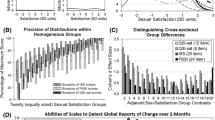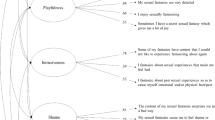Abstract
Two separate investigations were conducted to develop an objective self-report instrument, the Sexual Awareness Questionnaire (SAQ), designed to measure four personality tendencies associated with sexual awareness and sexual assertiveness: sexual-consciousness (attention to internal private sexual cues), sexual-monitoring (sensitivity to others' evaluation of one's sexuality), sexual-assertiveness (self-reliance in sexual decision making), and sex appeal-consciousness (awareness of one's own public sexiness). Factor and reliability analyses from both studies confirmed the factorial validity and reliability of the Sexual Awareness Questionnaire. Other results provided evidence supporting the convergent and discriminant validity of the SAQ. All four SAQ subscales tended to be negatively related to measures of sex-anxiety and sex-guilt for both males and females, and sexual-consciousness was directly related to erotophilic feelings. Other findings indicated that men's and women's responses to the four SAQ subscales were related in a predictable fashion to their sexual attitudes, dispositions, and behaviors. Research and clinical applications are discussed.
Similar content being viewed by others
References
Abbey, A. (1982). Sex differences in attributions for friendly behavior: Do males misperceive females' friendliness?Journal of Personality and Social Psychology, 42, 830–838.
Abbey, A., Cozzarelli, C., McLaughlin, K., & Harnish, R.J. (1987). The effects of clothing and dyad sex composition on perceptions of sexual intent: Do women and men evaluate these cues differently?Journal of Applied Social Psychology, 17, 106–126.
Abbey, A., & Melby, C (1986). The effects of nonverbal cues on gender differences in perceptions of sexual intent.Sex Roles, 15, 283–298.
Abrahamson, D.J., Barlow, D.H., Beck, J.G., Sakheim, D.K., & Kelly, J.P. (1985). The effects of attentional focus and partner responsiveness on sexual responding: Replication and extension.Archives of Sexual Behavior, 14, 361–371.
Allgeier, E.R., & Allgeier, A.R. (1988).Sexual interactions (2nd ed.). Lexington, Mass.: Health.
Bailey, W.C., Hendrick, C., & Hendrick, S.S. (1987). Relation of sex and gender role to love, sexual attitudes, and self-esteem.Sex Roles, 16, 637–648.
Beck, A.T. (1976).Cognitive therapy and the emotional disorders. New York: Meridian.
Beck, A.T., Ward, C.H., Mendelson, M., Mock, J., & Erbaugh, J. (1961). An inventory for measuring depression.Archives of General Psychiatry, 4, 561–571.
Beck, J.G., Barlow, D.H., & Sakheim, D.K. (1983). The effects of attentional focus and partner arousal on sexual responding in functional and dysfunctional men.Behavioral Research and Therapy, 21, 1–8.
Burt, M.R. (1980). Cultural myths and supports for rape.Journal of Personality and Social Psychology, 38, 217–230.
Carlson, M.I., Julsonnet, S., & Muehlenhard, C.L. (1988). Sexual assertiveness: Increasing women's skills in refusing unwanted sexual advances. Paper presented at the Western Region meeting of the Society for the Scientific Study of Sex, Dallas, TX.
Clark, M.S., Ouelette, R., Powell, M.C., & Milberg, S. (1987). Recipient's mood, relationship type, and helping.Journal of Personality and Social Psychology, 53, 94–103.
Clark, M.S., Taraban, C., Ho, J., & Wesner, K. (1989). A measure of exchange orientation. Unpublished manuscript, Carnegie Mellon University.
Fenigstein, A., Scheier, M.F., & Buss, A. (1975). Public and private self-consciousness: Assessment and theory.Journal of Consulting and Clinical Psychology, 43, 522–527.
Fisher, T.D. (1986). Parent-child communication about sex and young adolescents' sexual knowledge and attitudes.Adolescence, 83, 517–527.
Fisher, T.D. (1987). Family communication and the sexual behavior and attitudes of college students.Journal of Youth and Adolescence, 5, 481–495.
Fisher, T.D., & Hall, R.G. (1988). A scale for the comparison of the sexual attitudes of adolescents and their parents.Journal of Sex Research, 24, 90–100.
Fisher, W.A., Byrne, D., & White, L.A. (1983). Emotional barriers to contraceptions. In D. Byrne & W.A. Fisher (Eds.),Adolescents, sex, and contraception (pp. 207–239). Hillsdale, NJ: Erlbaum.
Fisher, W.A., Byrne, D., White, L.A., & Kelley, K. (1988). Erotophobia-erotphilia as a dimension of personality.Journal of Sex Research, 25, 123–151.
Gerrard, M. (1987). Sex, sex guilt, and contraceptive use revised: The 1980s.Journal of Personality and Social Psychology, 52, 975–980.
Hendrick, C., Hendrick, S., Slapion-Foote, M.J., & Foote, F.H. (1985). Gender differences in sexual attitudes.Journal of Personality and Social Psychology, 48, 1630–1642.
Hendrick, S. (1988). A generic measure of relationship satisfaction.Journal of Marriage and the Family, 50, 93–98.
Hendrick, S.S., & Hendrick, C. (1987). Multidimensionality of sexual attitudes.Journal of Sex Research, 23, 502–526.
Herold, E.S., & Way, L. (1988). Sexual self-disclosure among university women.Journal of Sex Research, 24, 1–14.
Hughes, T.G., & Snell, W.E., Jr. (1990). Communal and exchange approaches to sexual relations.Annals of Sex Research, 3, 149–164.
Janda, L.H., & O'Grady, K.E. (1980). Development of sex anxiety inventory.Journal of Consulting and Clinical Psychology, 48, 169–175.
Kaplan, H.S. (1974).The new sex therapy: Active treatment of sexual dysfunctions. Brunner/Maazel: New York.
Kaplan, H.S. (1979).Disorders of sexual desire. Brunner/Maazel: New York.
Larsen, K.S., & Long, E. (1988). Attitudes toward rape.Journal of Sex Research, 24, 299–304.
Leary, M.R., & Dobbins, S.E. (1983). Social anxiety, sexual behavior, and contraceptive use.Journal of Personality and Social Psychology, 45, 1347–1354.
Lefcourt, H.M. (1980). The construction and development of the Multidimensional-Multiattributional Causality Scales. In H.M. Lefcourt (Ed.),Advances and innovations in locus of control research. New York: Academic Press.
Maddox, J.M. (1976). Sexual health: An enrichment and treatment program. In D.H. Olson (ed.),Treating relationships. Lake Mills, Iowa: Graphic Publishing.
Master, W.H., & Johnson, V.E. (1970).Human sexual inadequacy. Little, Brown: Boston, MA.
Miller, L.C., Murphy, R., & Buss, A. (1981). Consciousness of body: Private and public.Journal of Personality and Social Psychology, 41, 397–406.
Mosher, D.L. (1965). Interaction of fear and guilt in inhibiting unacceptable behavior.Journal of Consulting Psychology, 29, 161–167.
Mosher, D.L. (1966). The development and multitrait-multimethod matrix analyses of three measures of three aspects of guilt.Journal of Consulting Psychology, 30, 25–29.
Mosher, D.L. (1973). Sex differences, sex experiences, sex guilt, and explicitly sexual films.Journal of Social Issues, 29, 95–112.
Mosher, D.L. (1977). The gestalt awareness-expression cycle as a model for sex therapy.Journal of Sex and Marital Therapy, 3, 229–242.
Mosher, D.L. (1979a). Sex guilt and sex myths in college men and women.Journal of Sex Research, 15, 224–234.
Mosher, D.L. (1979b). Awareness in gestalt sex therapy.Journal of Sex and Marital Therapy, 5, 41–56.
Mosher, D.L., & O'Grady, K.E. (1979). Homosexual threat, negative attitudes toward Sexual masturbation, sex guilt, and males sexual and affective reactions to explicit sexual films.Journal of Consulting and Clinical Psychology, 47, 860–873.
Rosenberg, M. (1965).Society and the adolescent self image. Princeton, NJ: Princeton University Press.
Sakheim, D.K., Barlow, D.H., Beck, J.g., & Abrahamson, D.J. (1984). The effect of spectatoring on subjective and physiological sexual arousal and the concordance of these response systems.Behavioral Research and Therapy, 22, 151–158.
Shields, S.A., Mallory, M.E., & Simon, A. (1989). The Body Awareness Questionnaire: Reliability and validity.Journal of Personality Assessment, 53, 802–815.
Snell, W.E., Jr., Belk, S.S., & Hawkins, R.C. II. (1986b). The Stereotypes About Male Sexuality Scale (SAMSS): Components, correlates, antecedents, consequences, and counselor bias.Social and Behavioral Sciences Document, 16, 9. (Ms. No. 2746)
Snell, W.E., Jr., Belk, S.S., & Hawkins, R.C. II (1990). Cognitive beliefs about male sexuality: The impact of gender roles and counselor perspectives.Journal of Rational-Emotive Therapy, 8, 249–265.
Snell, W.E., Jr., Belk, S.S., Papini, D.R., & Clark, S. (1989). Development and validation of the Sexual Self-Disclosure Scale.Annals of Sex Research, 2, 307–334.
Snell, W.E., Jr., & Finney, P. (1990). Interpersonal strategies associated with the discussion of AIDS.Annals of Sex Research 3, 425–451 (a).
Snell, W.E., Jr., & Finney, P. (1990). [Reliability and validity of the AIDS Empathy Scale]. Unpublished raw data (b).
Snell, W.E., Jr., Hawkins, R.C. II., & Belk, S.S. (1988). Stereotypes about male sexuality and the use of social influence strategies in intimate relationships.Journal of Social and Clinical Psychology, 7, 42–48.
Snell, W.E., Jr., & Papini, D.R. (1989). The Sexuality Scale: An instrument to measure sexual-esteem, sexual-depression, and sexual-preoccupation.Journal of Sex Research, 26, 256–263.
Snyder, M. (1974). Self-monitoring of expressive behavior.Journal of Personality and Social Psychology, 30, 526–537.
Snyder, M. (1979). Self-monitoring processes. In L. Berkowitz (Ed.), Advances in experimental social psychology, Vol. 12 (pp. 85–128). New York: Academic Press.
Snyder, M. (1987)Public appearances: Private realities. New York: W.H. Freeman and Company.
Twentyman, C.T., & McFall, R.M. (1975). Behavioral training of social skills in shy males.Journal of Consulting and Clinical Psychology, 43, 384–395.
Author information
Authors and Affiliations
Rights and permissions
About this article
Cite this article
Snell, W.E., Fisher, T.D. & Miller, R.S. Development of the Sexual Awareness Questionnaire: Components, reliability, and validity. Annals of Sex Research 4, 65–92 (1991). https://doi.org/10.1007/BF00850140
Issue Date:
DOI: https://doi.org/10.1007/BF00850140




